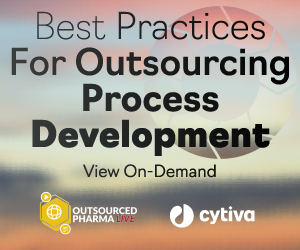Anticipating Manufacturing Costs — And Improving Process Development
By Brian James, Ph.D., Rondaxe

Of all the healthcare sector businesses, none get more scrutiny than the insurance and drug companies when it comes to pricing practices. Survival in the new business climate requires what my grandfather might refer to as an “attitude adjustment.” Pharma companies must assume that every new therapy brought to market will be picked apart relentlessly in terms of pricing as well as cost-benefit ratio; being proactive rather than reactive is the only viable option. The commercial pricing stage is not the time to develop an understanding of the cost structure — it is far too late in development. The process of drug development is time consuming and detailed. Undoubtedly over time, cost reduction opportunities have slipped by the wayside.
These opportunities summed up can significantly impact the profitability of your program. To avoid missing these opportunities and make the best decisions along the way, companies should perform and routinely update cost models for their programs. The models can range from the very basic (raw materials only) to extremely complex models. As with most endeavors in life, finding the balance between the two is the key.
Just The Facts: Raw Materials-Only Model
The basic raw materials model is the bare-bones version of cost of goods analysis; at a minimum, all analysis contains the raw materials as an underpinning. When I first started doing this type of modelling, we used pre-printed note pads and “filled in the blanks.” Eventually we moved to spreadsheet-based systems that at least allowed for modifications to flow through. The underlying concept of a raw materials-only model is simple at heart and based on the assumption that the raw materials are the predominant cost factor. By building up a bill of materials, determining the cost contribution for each material, and summing them up, a crude cost model is born.
There are several advantages to using this type of model, with the main benefit being speed. Generally, this type of model can be completed in a couple of hours. Although basic, users can identify the main raw material cost drivers for each step. Add in some minor modification, and the effect of yield on the raw materials cost can be uncovered as well. Problems identified at an early stage are problems that may be solved more readily. The basic model is also an effective tool for comparing multiple routes, although caution should be exercised when discarding routes early in the process.
Of course, the biggest disadvantage with this model is also the million-dollar question: What if it’s wrong? What if the raw materials are not the main cost driver at all? A process I evaluated for a client makes this point nicely. The client was convinced that a high-cost starting material was driving program costs, so they spent significant time and resources to negotiate better pricing. After a detailed analysis, it became obvious that their efforts were misplaced. Even at the high price, the raw material was contributing less than 5 percent of the total cost of manufacturing. In this case, a substantial cost reduction would have had virtually no impact on the total cost. Rather, a single step in the process suffered from both a low yield and a long cycle time. After identifying and working to correct the two major cost drivers, a 20 percent reduction in the overall cost of goods was achieved. Without the detailed cost analysis, the client may have never realized this level of cost savings and would have focused their efforts in an unproductive direction, only to be disappointed by the result.
Overall, these crude models have limited utility, especially in the early stages of a development program with small volumes, where processing costs are often a significantly higher proportion of cost. They should be considered a “quick and dirty” look at uncovering some of the key cost drivers of the development process.
I Love You Just The Way You Are, Now Change: Refining The Cost Model
The core of any cost model is the bill of materials that is constructed for each step; building up from this point determines the accuracy. One of the issues often encountered in the cost modeling process is user-introduced inconsistency. When multiple people are tasked with building models or a new person takes over, models for the same process can vary greatly in their results. To avoid the most common of errors, the group should agree on the source of pricing information. Does your organization use a system loaded with prices or do you take them from the Aldrich catalog? Does one person aggressively increase yields based on assumed improvements when another person is more conservative? These small differences in approach can add up to major differences in the final cost analysis. Who can you trust?
Taking the next step also requires the user to examine processing costs at a more granular level. Processing costs can be broken down into several categories, including facility, labor, and waste disposal. These can be further influenced by cycle times and special considerations such as containment facilities for high potency compounds.
For example, a portion of processing costs must include the facility. What does it cost to run a small pilot plant for a year? What is the capacity of the reactors in the plant? How much more would it be if it were a high-potency lab? This top-level breakdown is usually sufficient, but if you really wanted to you could break out depreciation, utilities, maintenance, taxes, and so forth. A very fine level of granularity could include a further breakdown of utilities into gas, steam, coal, electricity, and so on. At this point, the effort is rarely enlightening. The more detail you input, the less likely you are to run that specifically modeled process in the plant (I think some guy named Heisenberg came up with that one).
The next processing components that need to be included are the labor force. What is the average cost of your operations staff on an hourly basis? Do they operate on a 24/7, 24/5, 16/5, or some other schedule? Is your process intensive so you need 3 or 4 operators assigned to a step? How much professional support do they need from the engineers, process chemists, or QC group? A process with 20 IPCs may require more evaluation from the process chemist compared with a routine process that is well worked out and running smoothly.
Another component of the processing cost that should be considered is waste disposal and solvent recycling. A volume-inefficient process renders this cost significant, and solvent recovery and recycling can mitigate the overall cost tremendously.
As you can see, the considerations can be endless and incredibly detailed. The decision as to which parameters to include is largely based on the nature of the project and the level of accuracy required from the cost model. Regardless of the inputs into the model, assumptions should be standardized and shared among the team members so that consistency can be built into the process.
What Have You Done For Me Lately? Using The Cost Model To Guide Business Decisions
Once you have decided on the level of detail that you need and completed the model, what can you use it for? Certainly, there are many more uses for a cost model than defending your pricing before a joint session of Congress. Some common purposes include:
- Process development decisions
- Supplier negotiation
- Investor presentation
Rather than go into specifics of each, we can focus on the first: process development decisions. During the process of building up your cost model, you will be able to identify potentially non-obvious cost drivers. Once you have an accurate handle on what is driving costs, you can work to improve those areas.
Another client had an established route to their API that had successfully delivered material for early clinical trials. It was expensive and there were concerns that the manufacturing costs could terminate the program. They embarked on a route-scouting program in which no fewer than 10 different syntheses were attempted. From that pool, however, only two were viable. At this point, the model for the existing route was updated and models for the other two were prepared for comparison. After careful consideration, some potential improvements to all three processes were evaluated. While the original route with several years of development was currently the most cost effective, it offered the least upside potential. Based on the potential and very realistic development opportunities, one of the alternative routes was put into development and most of the proposed improvements were realized in a relatively short time.
No matter the type of organization you are in — from big pharma to virtual, small molecule to biologics, active ingredient to drug product — it is important to understand the cost structure of your program. There are tools available from pen and paper to spreadsheets and custom applications to help you understand your costs and make more informed decisions. Although building a cost of goods model may seem daunting at first, after you get a few under your belt, it becomes easier and will help your program greatly.
About The Author:
 Brian James, Ph.D., MBA, is the SVP of operations at Rondaxe, a pharmaceutical CMC consulting and software firm. Brian oversees project management, API synthesis design, and API/formulation sourcing support to Rondaxe clients. He manages and oversees projects ranging from pre-IND chemistry development to pre-launch validation and material sourcing for late-stage clinical trials. Prior to joining Rondaxe, he was with Bristol-Myers Squibb, where he honed his skills and expertise in API synthesis and sourcing strategies. Brian received his Ph.D. in chemistry from University of California and his MBA from Le Moyne College, and performed his post-doctoral fellowship at Colorado State University.
Brian James, Ph.D., MBA, is the SVP of operations at Rondaxe, a pharmaceutical CMC consulting and software firm. Brian oversees project management, API synthesis design, and API/formulation sourcing support to Rondaxe clients. He manages and oversees projects ranging from pre-IND chemistry development to pre-launch validation and material sourcing for late-stage clinical trials. Prior to joining Rondaxe, he was with Bristol-Myers Squibb, where he honed his skills and expertise in API synthesis and sourcing strategies. Brian received his Ph.D. in chemistry from University of California and his MBA from Le Moyne College, and performed his post-doctoral fellowship at Colorado State University.

